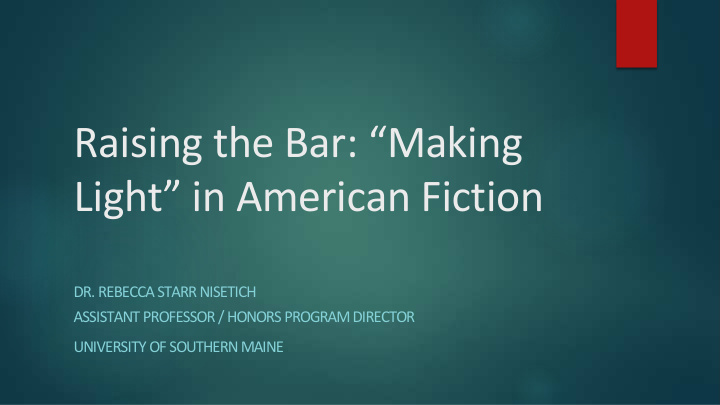



Raising the Bar: “Making Light” in American Fiction DR. REBECCA STARR NISETICH ASSISTANT PROFESSOR / HONORS PROGRAM DIRECTOR UNIVERSITY OF SOUTHERN MAINE
I ask: What is “race” and why does it matter? I find answers in texts by American writers.
Puddn’head Wilson an d The Sellout Mark Twain (1835-1910) Paul Beatty (1962- )
PRESENTATION ROADMAP: 1. Historical and Legal Contexts 2. Puddn’head Wilson 3. The Sellout
Plessy v. Ferguson (1896) “... legislation is powerless to eradicate racial instincts or to abolish distinctions based upon physical differences…” “Stateways cannot change folkways.”
Felon Disenfranchisement, 2016
Felon Disenfranchisement, con’t: Black Americans are more than four times more likely to lose - their voting rights than the rest of the adult population. One of 13 black adults are disenfranchised nationally. - Rates of disenfranchisement are higher in Florida (21%), - Kentucky (26%), Tennessee (21%), Virginia (22%). Nationwide, 2.2 million black citizens are currently banned from - voting.
Carol Anderson, White Rage : White rage… works its way through the courts, the legislatures, and a range of governmental bureaucracies... Working the halls of power, it can achieve its ends far more effectively, far more destructively. The trigger for white rage is black advancement… A formidable array of policy assaults and legal contortions has consistently punished black resilience, black resolve.
Roxy switches Tom and Chambers at birth: Tom = Roxy’s son, and is 1/32 nd “black” Chambers = Percy Driscoll’s son, and is “white”
“ … his manners were the manners of a slave. Money and fine clothing could not mend these defects nor cover them ” up… “In Twain’s novel, fiction and law imitate one another, and the greatest challenge, in the end, is to separate ‘racism’ from its parodic critique.”
Twinning in Puddn’head Wilson and “Those Extraordinary Twins Their story was one story, the new peoples’ story was another story, and there was no connection between them… so I dug out the farce and left the tragedy…
Margaret Garner’s story...
Margaret Garner’s trial: Lucy Stone: “The faded faces of the Negro children tell too plainly to what degradation the female slaves submit. Rather than give her daughter to that life, she killed it. If in her deep maternal love she felt the impulse to send her child back to God, to save it from coming woe, who shall say she had no right not to do so?”
Twain critiques the legal treatment of some human beings as property… “Everybody granted that if ‘Tom’ were white and free it would be unquestionably right to punish him-- it would be no loss to anybody; but to shut up a valuable slave for life--that was quite another question. As soon as the Governor understood the case, he pardoned Tom at once, and the creditors sold him down the river.” (121)
Twain underscores the ways that legal discourse is used as a neutral cover for state-sanctioned racial violence. As Twain’s novel demonstrates, theoretical legal debates have real and lasting consequences.
Satirizing segregation in The Sellout De Jure Segregation: De Facto Segregation:
Huckleberry Finn , reimagined… The Pejorative-Free Adventures and Intellectual and Spiritual Journeys of African American Jim and His Young Protégé, White Brother Huckleberry Finn as They Go in Search of the Lost Black Family Unit
The Adventures of Tom Soarer “On the cover of Tom Soarer, a preppy black boy, wearing penny loafers and argyle socks exposed by a pair of flooding whale-print lime-green pants, and armed with a bucket of whitewash, stood bravely in front of a wall splashed with gang graffiti, while a pack of ragamuffin hoodlums looked on menacingly.” ( The Sellout , 217)
“ Who am I? And how may I become myself? ” T HE S ELLOUT P . 250
“ On that bus it’s like the specter of segregation has ” brought the city together T HE S ELLOUT P . 163
“ Sometimes I’d chance across an elderly member of the community standing in the middle of the street, unable to ” cross the single white line… And why was that? When it was just a line. T HE S ELLOUT P . 108
THE WHEATON ACADEMY CHARTER MAGNET SCHOOL OF THE ARTS, SCIENCES, HUMANITIES, BUSINESS, FASHION AND EVERYTHING ELSE
Los Angeles County Housing by Race
“It’s illegal to yell ‘fire’ in a crowded theater, right? Well, I’ve whispered racism in a post-racial world…” THE SELLOUT , P. 262
“ … the burden of being black and constantly having to ” decide when and if I give a shit about it T HE S ELLOUT P . 257
“ So, what exactly is our ” thing? T HE S ELLOUT , P . 288
We cannot escape the racist structures that define our worlds until we have created other options for defining the self, in law and in life.
Recommend
More recommend